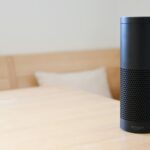As we approach 2025, the evolution of smart speakers with virtual assistants has reached a pivotal juncture, with technological advancements significantly enhancing their utility and integration into our daily lives. This guide examines the top five smart speakers that not only promise superior audio quality and seamless smart home integration but also emphasize stringent privacy measures and adaptability to individual user environments. The features and functionalities of models like the latest Amazon Echo Studio and the Sonos Era 300 with Dolby Atmos are dissected to understand their impact on both casual users and tech enthusiasts. Join us as we explore how these devices are set to transform your home and lifestyle, and why understanding their differences could be key to optimizing your digital ecosystem.
Amazon Echo Studio (Newest Model)
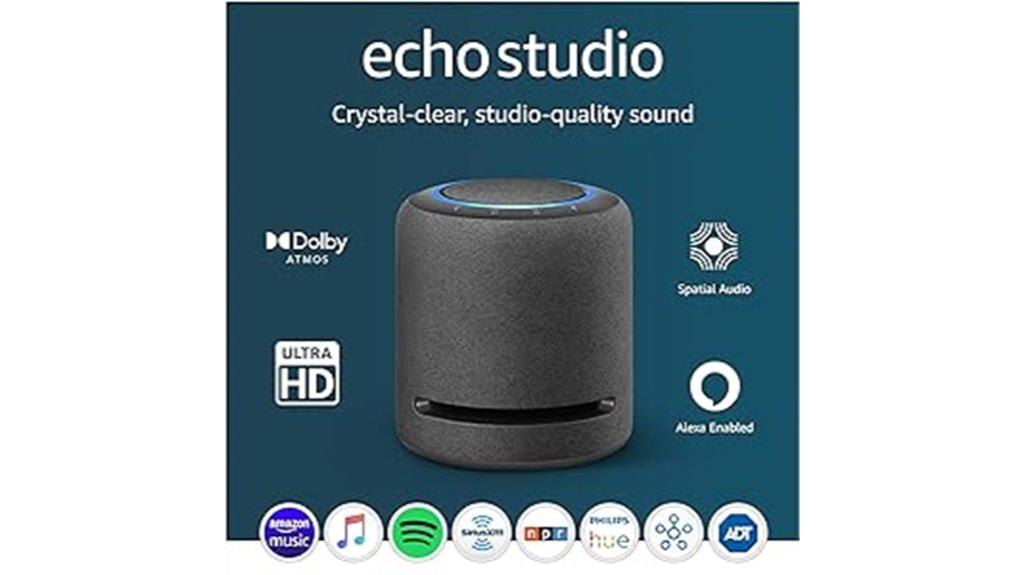
The Amazon Echo Studio, released as the latest model in 2025, stands out as the pinnacle of smart speaker technology for audiophiles and tech enthusiasts alike. Designed for expansive spaces such as living rooms, this charcoal-colored device is celebrated for delivering the best sound quality among Alexa speakers. It features an array of five speakers that manage to produce a powerful bass, dynamic midrange, and crisp highs. Enhanced by Dolby Atmos, the audio gains space, clarity, and depth, creating an immersive listening environment. Notably, the Echo Studio smartly adapts to room acoustics to optimize audio output and supports voice-controlled music streaming from platforms like Amazon Music, Apple Music, and Spotify. Additionally, it serves as a hub for controlling compatible smart home devices, offering utility beyond exceptional sound.
Best For: Audiophiles and tech enthusiasts looking for a smart speaker that delivers superior sound quality and smart home connectivity in large spaces.
Pros:
- Exceptional sound quality with Dolby Atmos and spatial audio processing for an immersive audio experience.
- Built-in smart home hub allows for easy control of compatible devices via voice commands.
- Automatically adjusts to the room’s acoustics to optimize sound quality.
Cons:
- Initial setup and pairing with other devices can be complex and time-consuming.
- Limited to no stereo mode connectivity via Bluetooth and issues with Amazon Music app playback.
- Bulky design may not integrate well into every interior décor.
Sonos Era 100 – Black – Wireless, Alexa Enabled Smart Speaker
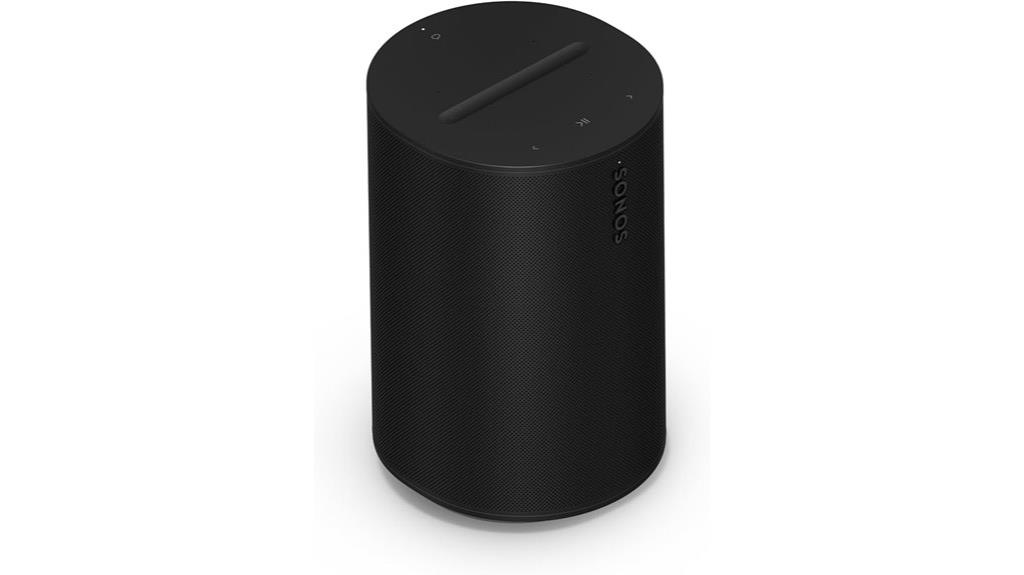
For individuals seeking a blend of sophisticated design and powerful performance in a smart speaker, the Sonos Era 100 emerges as an excellent choice. This compact device boasts a 47% faster processor and dual-tweeter acoustic architecture, ensuring detailed stereo separation and deep bass. It fits seamlessly into various settings, from bookshelves to kitchen counters. The Sonos Era 100 supports multiple connectivity options including WiFi, Bluetooth, and NFC, and features an easy setup with the Sonos app for optimal sound calibration. Constructed from durable Polycarbonate, it includes stereo pairing and a USB port for versatile use. With customer reviews praising its sound quality and setup ease, the Sonos Era 100 stands out in the market, despite some concerns over software updates.
Best For: Music enthusiasts and tech-savvy users looking for a high-performance, versatile smart speaker with advanced connectivity options.
Pros:
- Enhanced audio performance with a 47% faster processor and dual-tweeter design for superior stereo separation and bass.
- Multiple connectivity options including WiFi, Bluetooth, NFC, and Airplay, offering flexibility in usage across various devices.
- Compact and durable design, making it suitable for a range of environments like kitchens, bedrooms, and living spaces.
Cons:
- Some users have reported issues with streaming functionality and app usability following software updates.
- Lacks built-in battery, limiting portability as it requires being plugged into a power source.
- While it supports Alexa, it might require additional components like a Sonos subwoofer for optimal sound quality, increasing the overall investment.
Bose Portable Smart Speaker with Alexa Voice Control
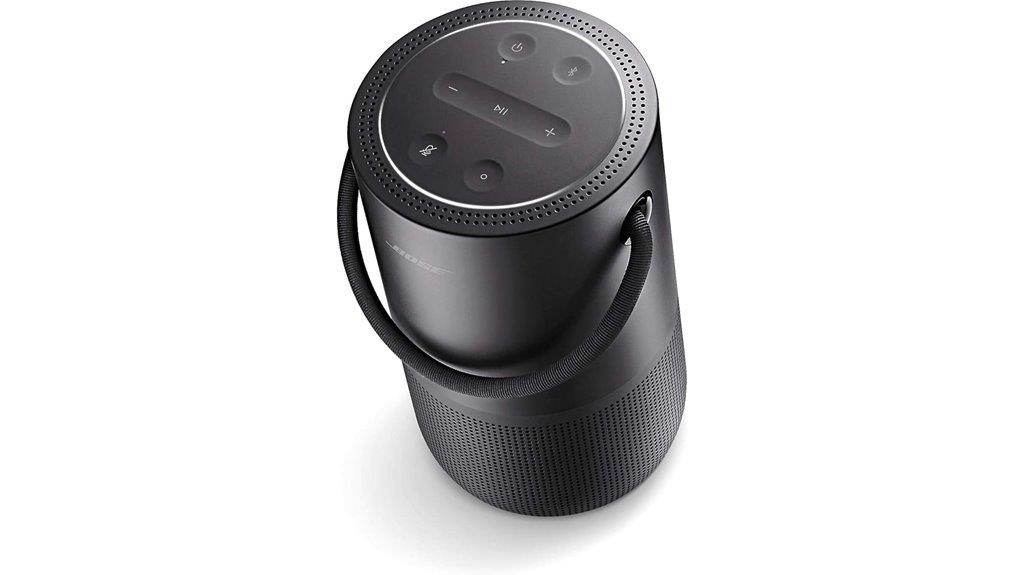
Equipped with innovative 360-degree sound technology and Alexa Voice Control, the Bose Portable Smart Speaker emerges as an ideal option for audiophiles seeking a high-quality listening experience in any environment. This compact device offers wireless Bluetooth and Wi-Fi connectivity, ensuring seamless streaming from popular services like Amazon Music and Spotify. Its durable, water-resistant design and a battery life of up to 12 hours make it perfect for both indoor and outdoor use. Users can control the speaker through voice commands, touch, or the Bose Music app, making it incredibly user-friendly. Despite its higher price point and some connectivity issues noted by users, the speaker’s superior sound quality and portability continue to draw praise, securing its place as a top contender in today’s market.
Best For: Audiophiles and outdoor enthusiasts looking for a durable, high-quality sound system with smart features.
Pros:
- Superior 360-degree sound quality with powerful bass
- Built-in Alexa and Google Assistant for easy voice control
- Portable and durable design, suitable for both indoor and outdoor use
Cons:
- High price point compared to other Bluetooth speakers
- Connectivity issues with the Bose Music app
- Not fully water-resistant, limiting some outdoor usage possibilities
Sonos Era 300 Smart Speaker with Dolby Atmos
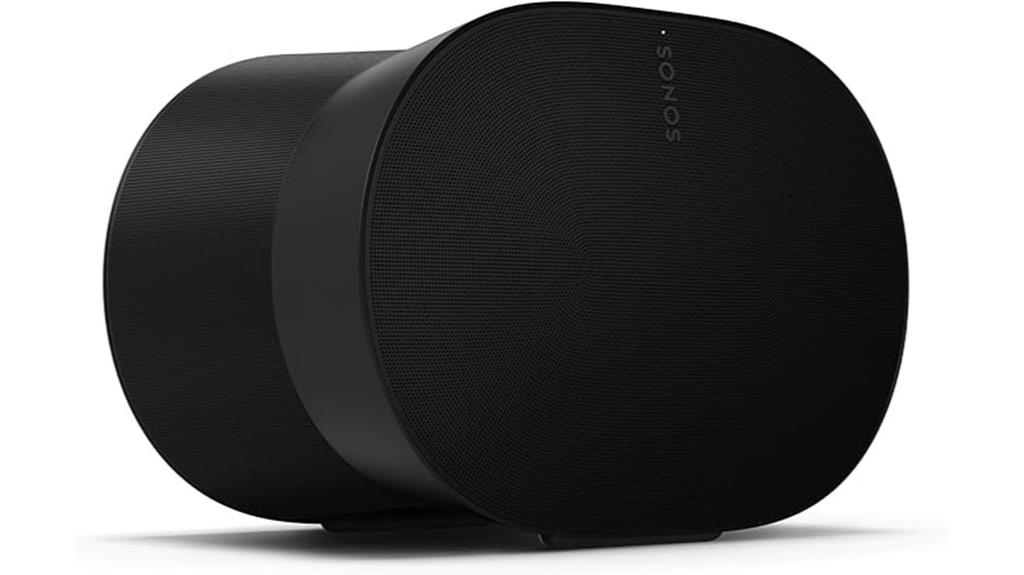
Unveiled in March 2023, the Sonos Era 300 smart speaker introduces an exceptional audio experience, courtesy of its Dolby Atmos support and six strategically placed drivers. This wireless, Alexa-enabled device stands out with its custom waveguides, enhancing sound dispersion for a truly immersive listening environment. Measuring 6.65 inches in depth and width, and 7.44 inches in height, it weighs 9.85 pounds and sports a sleek black finish. Users benefit from various connectivity options including WiFi, Bluetooth, and auxiliary inputs for diverse audio sources. The Sonos Era 300 shines in multichannel setups, particularly when paired with Sonos Arc or Beam, creating a robust, wall-to-wall soundstage. Its Trueplay tuning feature optimizes audio based on room acoustics, ensuring the best possible sound quality in any environment.
Best For: Music enthusiasts seeking a high-quality, immersive audio experience with smart home integration.
Pros:
- Supports Dolby Atmos for a spatial audio experience.
- Six drivers and custom waveguides ensure exceptional sound dispersion.
- Versatile connectivity options including WiFi, Bluetooth, and auxiliary input.
Cons:
- Some users find the setup process challenging.
- Heavier than typical smart speakers, which may affect portability.
- Requires additional components like Sonos Arc or Beam for optimal surround sound setup.
Apple HomePod Smart Speaker 2nd Generation (Midnight)
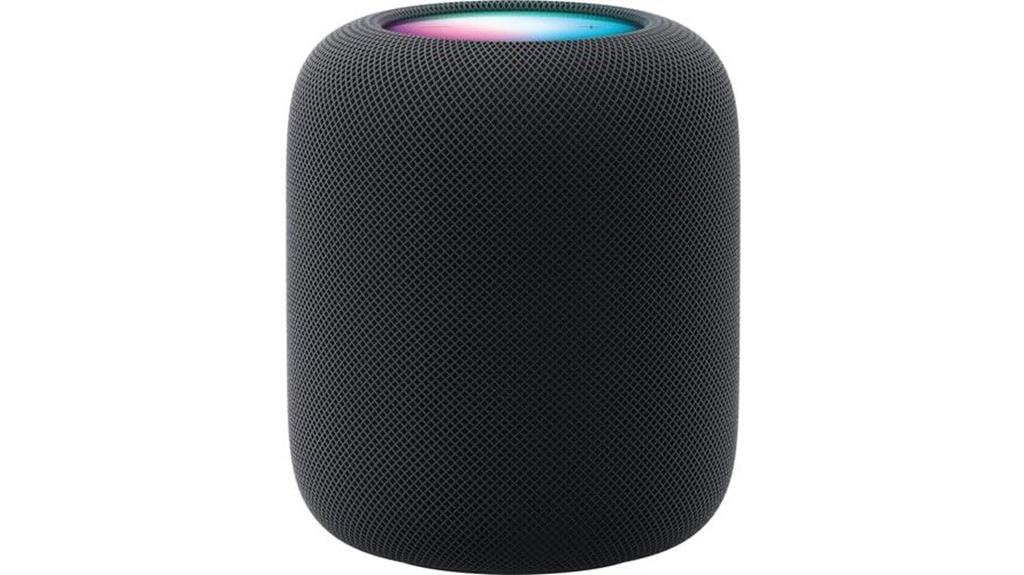
The Apple HomePod Smart Speaker 2nd Generation (Midnight) emerges as an exceptional choice for audiophiles seeking a superior listening experience, seamlessly integrated into the smart home ecosystem. Equipped with a high-excursion woofer and five beamforming tweeters, this device delivers deep, room-filling bass and crystal-clear high frequencies. The inclusion of Spatial Audio enables a surround sound experience, enhancing audio realism. Additionally, real-time acoustic optimization tailors playback by adapting to the room’s acoustics using sensor feedback. With Siri built-in, users can manage smart home devices, schedule tasks, and even utilize an intercom feature. Compatibility with Apple’s ecosystem, including AirPlay and Apple Music, ensures a cohesive and user-friendly experience. This smart speaker not only excels in sound quality but also in smart home integration and privacy protection.
Best For: Audiophiles and tech enthusiasts looking for a high-quality smart speaker that offers exceptional sound and seamless integration with Apple’s ecosystem.
Pros:
- Exceptional audio quality with a high-excursion woofer and beamforming tweeters for clear, immersive sound.
- Comprehensive smart home integration with built-in Siri, compatibility with Matter and Thread, and functions as a hub for controlling smart devices.
- Enhanced privacy features ensuring user data protection and secure smart home management.
Cons:
- Limited compatibility primarily with Apple devices, which may alienate non-Apple users.
- Positioned in a higher price bracket compared to other smart speakers on the market.
- Requires a stable internet connection for optimal functionality, which might be a constraint in areas with poor connectivity.
Factors to Consider When Choosing Smart Speakers With Virtual Assistants in 2025
When selecting smart speakers with virtual assistants in 2025, several critical factors must be considered to enhance user experience and functionality. Key considerations include the compatibility of the voice assistant with other devices, the quality of audio output, and the extent of smart home integration. Additionally, evaluating connectivity options and assessing the design and portability of the speaker can significantly influence the decision-making process.
Voice Assistant Compatibility
Choosing a smart speaker in 2025 involves carefully considering the compatibility of the voice assistant with your existing technology ecosystem. Popular voice assistants like Alexa, Google Assistant, and Siri each offer unique advantages, depending on whether you prioritize smart home control, music streaming capabilities, or user interface intuitiveness. It’s crucial to select a smart speaker that aligns with the devices and services you already use to ensure a seamless integration.
Additionally, the ability of the smart speaker to support multiple voice commands and manage complex queries significantly enhances user experience and convenience. This feature allows for more natural interaction and a broader range of functionalities, making everyday tasks simpler.
It is also important to consider how frequently the smart speaker receives updates. Regular updates not only improve functionality but also introduce new features that can keep the device current over its lifespan. Lastly, evaluate the privacy settings and data management practices of the voice assistant. Understanding how your data is handled can help you make an informed decision, ensuring you choose a smart speaker that you feel comfortable using in your personal space.
Audio Quality Evaluation
Assessing audio quality is paramount when selecting smart speakers equipped with virtual assistants in 2025. Advanced audio technologies like Dolby Atmos and spatial audio processing are key features to look for, as they significantly enhance the clarity and depth of the sound. Such technologies create a more immersive listening environment, making these speakers an excellent choice for both music aficionados and everyday users.
Furthermore, the configuration and number of drivers within the speaker play a crucial role. Multiple drivers, strategically arranged, can dramatically improve sound separation and enrich the bass response, leading to a fuller audio experience. This setup helps in delivering crisp, clear sound across various music genres and spoken content.
Additionally, the ability of a speaker to adapt automatically to the acoustics of its environment cannot be overstressed. Technologies like Trueplay tuning optimize sound based on the speaker’s placement within a room, ensuring the best possible audio performance. It’s also advisable to check user reviews focusing on how these speakers perform at high volumes, particularly their capacity to maintain sound clarity without distortion. This real-world feedback can provide invaluable insights into the speaker’s performance under different conditions.
Smart Home Integration
Smart speakers with virtual assistants have become central hubs for home automation by 2025, allowing users to control a wide array of compatible smart home devices with simple voice commands. These devices streamline the management of lighting, security systems, and thermostats, offering unprecedented convenience and enhanced living environments.
Key to these advancements, support for smart home protocols like Matter and Thread is crucial. These protocols ensure seamless integration and interoperability among devices from various manufacturers, simplifying the setup process and enhancing user experience. This compatibility allows for the creation of diverse ecosystems within the home, where devices communicate effectively, ensuring efficient operation.
Moreover, the ability to program automation routines and schedules adds another layer of convenience. Users can automate daily tasks such as adjusting room temperatures or turning off lights based on their preferences and schedules, which not only enhances comfort but also contributes to energy efficiency.
Privacy features in these smart speakers have also evolved, providing robust security measures that protect personal data while still allowing for the comprehensive control of smart home devices. Additionally, developments in spatial audio and real-time acoustic optimization elevate the entertainment experience, offering immersive sound quality that enhances multimedia systems in smart homes.
Connectivity Options
When selecting a smart speaker with virtual assistants for future use in 2025, a critical factor to consider is the array of connectivity options available. These options determine how well the device will integrate with other technology in your home, affecting everything from ease of use to audio quality.
Firstly, ensure the speaker supports essential standards like Wi-Fi and Bluetooth, which are pivotal for streaming audio from various sources and connecting with mobile devices. Speakers with auxiliary inputs are also valuable for those who might want to connect older devices without wireless capabilities.
Additionally, the ability to connect multiple speakers via multi-room audio capabilities is crucial for users looking to create a cohesive sound system throughout their home. This feature allows the same or different music to be played in various rooms simultaneously, all controlled from one point.
Advanced connectivity features such as AirPlay, NFC, and USB ports can significantly enhance user experience. AirPlay allows for streaming from Apple devices with high-quality audio transmission, NFC enables quick pairing with compatible devices, and USB ports offer direct connections, broadening the usability of the speaker.
Lastly, compatibility with smart home ecosystems is essential for those invested in a connected home, enabling control of lighting, heating, and other smart devices directly through the speaker’s interface.
Design and Portability
Considering the evolving needs of technology users, the design and portability of smart speakers with virtual assistants are paramount when making a selection for 2025. As users increasingly demand versatility, the physical dimensions and weight of these devices play a critical role. Compact models, typically measuring between 5 to 7 inches in height, are ideal for integration into limited spaces such as on shelves, counters, or desks, ensuring they do not dominate your living or working areas.
Moreover, the weight of these speakers, often ranging from 2 to 5 pounds, enhances their portability. This lightweight design allows for effortless transportation and repositioning within different environments—whether it’s moving from room to room at home or taking the device outdoors. Speaking of outdoor usage, durability becomes a significant factor. Features like water resistance are essential for speakers used near water sources or in outdoor settings, aiding in the prevention of damage and maintaining performance longevity.
Lastly, the aesthetic appeal and material quality of the smart speakers should not be overlooked. The design should seamlessly blend with or compliment your home décor, offering options from sleek, modern finishes to more robust, outdoor-friendly designs. These considerations ensure both functional and visually pleasing additions to your tech-savvy home.
Privacy and Security
As consumers increasingly integrate technology into their everyday lives, the privacy and security of smart speakers with virtual assistants become critical factors to consider in 2025. With advancements in encryption technologies, these devices now prioritize safeguarding personal data against unauthorized access. This security is bolstered by allowing users to manually disable microphones or cameras, enhancing control over personal data collection.
Manufacturers have also improved transparency regarding how user data is utilized and stored. Clearly outlined policies ensure users are well-informed about the management of their information, building trust and confidence in the technology. Furthermore, many smart speakers have shifted to on-device processing. This change minimizes the volume of data transferred to cloud servers, significantly reducing the risk of privacy breaches through external transmissions.
Additionally, the introduction of advanced sound recognition technologies in smart speakers ensures that while tasks are automated efficiently, sensitive personal information is kept secure from third-party access. These enhancements collectively address the growing concerns about privacy and security, making the latest smart speakers not only more capable but also safer for everyday use in an increasingly connected world.
Price and Value
In the rapidly evolving market of smart speakers with virtual assistants, discerning buyers must weigh the price against the value offered. High-end models, often featuring advanced audio technologies such as Dolby Atmos and spatial audio, justify their premium through enhanced sound quality. These speakers not only deliver superior audio experiences but also come equipped with features like bass boost and sophisticated voice control, enriching user interaction and satisfaction.
When assessing value, consider the speaker’s ability to integrate seamlessly with smart home systems and support multi-room audio setups. Such functionalities extend the utility of the device beyond mere sound output, transforming it into a central hub for home automation.
Additionally, prospective buyers should explore available trade-in programs and discounts. These options can make acquiring a top-tier smart speaker more affordable without compromising on quality. It’s also wise to scrutinize customer reviews and ratings; they are indicative of the product’s reliability and performance, helping to ensure that the investment is sound.
Lastly, factor in the ongoing costs of any necessary subscriptions for music streaming or enhanced features, as these will affect the overall financial outlay over the speaker’s lifespan.
Future Proofing Features
Why should consumers focus on future-proofing features when selecting smart speakers with virtual assistants for 2025? As technology evolves rapidly, choosing devices with advanced adaptability ensures long-term relevance and enhanced user satisfaction. Smart speakers that support multiple connectivity options like Wi-Fi, Bluetooth, and auxiliary inputs are crucial. This versatility guarantees compatibility with a wide array of devices and upcoming technology standards, preventing obsolescence.
Moreover, considering speakers with built-in support for cutting-edge audio technologies such as Dolby Atmos and spatial audio is wise. These features not only elevate the audio experience but are also in line with the progression of content formats, offering a future-ready solution for media consumption.
Regular software updates are another essential factor. They expand functionality, integrate new features, and refine the user interface, thereby extending the lifespan of the product. Additionally, the capability to seamlessly integrate with various smart home ecosystems, especially those supporting new standards like Matter, ensures that the speaker remains a central, versatile component of home automation.
Lastly, opting for speakers equipped with advanced voice recognition technology is critical. Improved responsiveness and accuracy are vital as virtual assistant technologies become increasingly sophisticated, making interactions more intuitive and efficient.
Conclusion
In conclusion, the advanced capabilities of the top five smart speakers in 2025 exemplify significant strides in audio technology and smart home integration. These devices not only enhance audio experiences through superior sound quality and immersive technologies like Dolby Atmos but also emphasize robust privacy controls and aesthetic versatility. As they become integral to modern lifestyles, selecting the right model requires careful consideration of privacy, connectivity, audio quality, and design to best meet individual needs and preferences.




